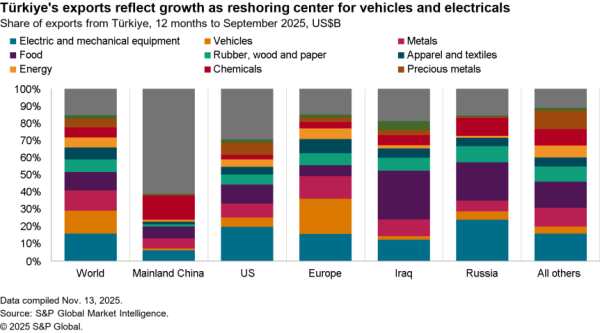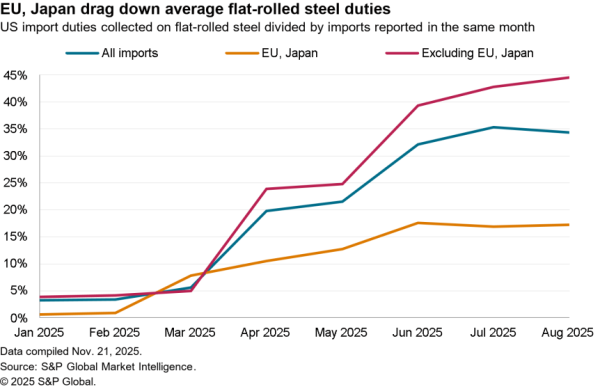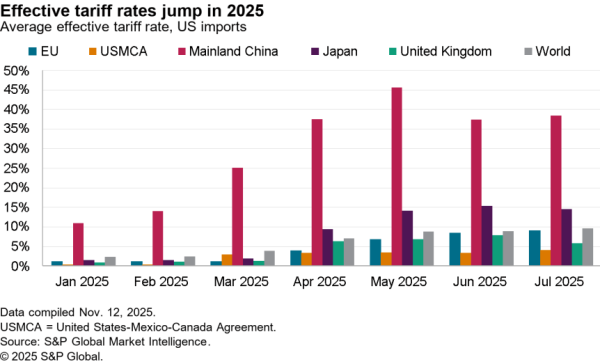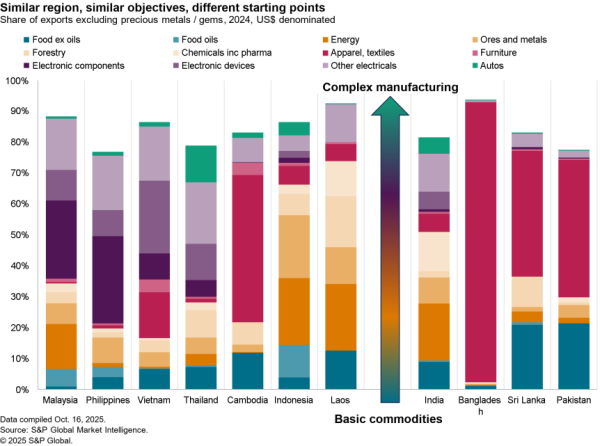1.Trump’s TRADE – Target Rich, Arguably Difficult Environment
President-elect Trump is unlikely to wait long after his inauguration on January 20 to launch initial trade measures, particularly if they can be specifically linked to increasing U.S. employment. The Peterson Institute suggests he can use Presidential powers to launch a number of measures including tariffs of up to 15%. Press reports, including CNN, suggest specific tariffs of 5% to 10% on a broad basis could be applied. A tax bill including adaptations to border taxes, supported by Republican representatives last June, may also be possible. The President-elect has also shown a willingness to intervene directly, taking a holistic approach to deals with companies including those with United Technologies and Softbank.
Panjiva data shows the initial countries and regions to focus on, based on the U.S. trade deficit from goods imports and exports, would be China ($348 billion deficit in the past 12 months), the European Union ($138 billion), Japan ($68.3 billion), Mexico ($61.5 billion), Vietnam ($31.8 billion) and South Korea ($29.6 billion). The challenge is that all but seven of its top 25 deficit partners are either already in, or negotiating to join, free trade areas which may limit the potential for bilateral deals.

Source: Panjiva
2.Nafta 2.0 = TPP 1.0?
Another potential signature policy for the incoming U.S. administration is a renegotiation of the North American Free Trade Agreement (NAFTA). Starting the process can be handled via Presidential decree as per Chapter 22 of NAFTA, though approval of the revised deal would require congressional approval. Notably both Canada and Mexico have welcomed a renegotiation as the deal does not include a number of measures such as trade in digital goods. Such a deal could end up resembling the Trans-Pacific Partnership which is broader in scope than Nafta in that it includes labor and environmental standards.
Negotiations would be far from simple. While the U.S. runs an overall $62 billion goods deficit with Mexico and $9.6 billion with Canada over the 12 months to October 31, there are many industries where it runs a surplus and may therefore lose out. One example is in autos, where the U.S. ran a net deficit of $46.7 billion in the 12 months to October 31 with Canada and Mexico, Panjiva data shows. Yet total trade (including imports and exports of parts and completed autos) was $165.4 billion. Manufacturers may choose to move their entire value chains out of the U.S. and import vehicles with a tariff applied.

Source: Panjiva
3.Lumbering Forward
The lapsed Softwood Lumber Agreement between the U.S. and Canada dissolved into a trade investigation, as discussed in Panjiva research of December 19, with the U.S. Department of Commerce starting a formal investigation of export practices. While this may be overshadowed by the broader NAFTA renegotiation, it may be a test case for U.S./Canada relations. Initial decisions in the preliminary review could emerge by January 9, but the whole process could take until mid-year. Panjiva data shows Canadian exports have increased by 55.2% in November on a year earlier after an 84.5% increase in October. Tolko and West Fraser have grown their market share the most aggressively.

Source: Panjiva
4.RCEP 0.5 – Really China’s Expansion Plan
China will likely want to conclude at least a draft agreement on the Regional Comprehensive Economic Partnership (RCEP) by the end of 2017. The deal, which in its current form will include with the ASEAN countries and those with existing FTAs with ASEAN, will next be up for discussion in February, but will likely be the focus of most multilateral meetings among the partners during the year.
Reaching a deal would also make it more complex for President-elect Trump to negotiate updated bilateral deals, for example with South Korea if it includes ‘most favored nation’-type clauses. Panjiva data for Chinese imports and exports shows the most important counterparties are Japan and South Korea in terms of China’s total trade, both of which it has a deficit with. One potential complication is the Chinese government’s national congress in October 2017, which will finalize leadership for next five year, The Economist reports.

Source: Panjiva
5.Trade Deal for Climate Change vs. Changing Climate for Trade Deals
Broad ascent on a wide-ranging trade deal doesn’t necessarily mean that it will get done. Apparent consensus on the desirability of the Environmental Goods Agreement did not translate into a formal deal, after China declined to take part in final negotiations, as discussed in Panjiva research of December 5. While President-elect Trump may not be willing to get involved in such a broad, multilateral deal it could resurface as part of China’s broader trade strategy. There is an economic argument for China to push on with a deal – Panjiva data shows China’s exports of solar energy equipment fell 27.1% in the 12 months to October 31, though some Chinese manufacturers have moved production to other countries.

Source: Panjiva
6.Material Differences, Agri-Aggravations at WTO
Both the U.S. and EU have launched WTO complaints about China’s exports of raw materials including copper, graphite and lead as discussed in Panjiva research of November 10. Additionally the U.S. has lodged complaints about Chinese support for its agricultural sector. These disputes could take much of the year to resolve. They will also be complicated by continued evolution in detailed Chinese trade policy – one recent example being cuts in export taxes on copper and aluminum products. China’s exports of the products concerned increased 43.7% in the three months to October 31 on a year earlier, Panjiva data shows. Yet, U.S.-bound shipments fell 12.9% and those to the EU rose just 9.8% over the same period.

Source: Panjiva
7.Brexit Busy, Going Nowhere
The British government has committed to triggering its exit from the EU under Article 50 by the end of March. A short-term trade deal with the EU following this looks very unlikely. The process of exit could take up to two years, but can be further extended by unanimous agreement of the European Council.
Even if the U.K. can reach a deal with the European Commission, it still has to be approved by 38 regional and national assemblies. The complexity of approving CETA, which was seven years in the making, make for a discouraging precedent. Panjiva analysis of official data shows the U.K.’s largest bilateral partners in the EU are (in order of total trade) Germany, the Netherlands, France, Belgium and Ireland . It is also worth noting that comments from the incoming U.S. administration and Chinese government on wanting to sign new deals with the U.K. cannot be formally taken forward until the U.K. has exited the EU.

Source: Panjiva




